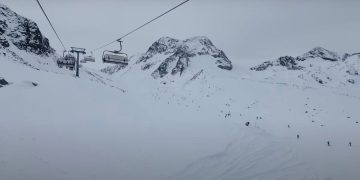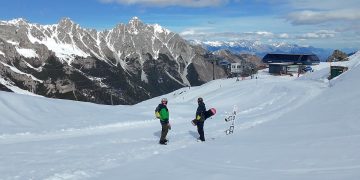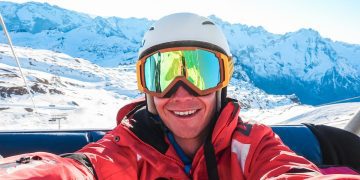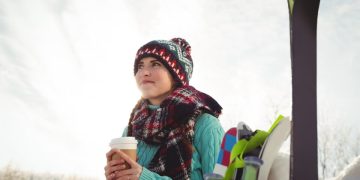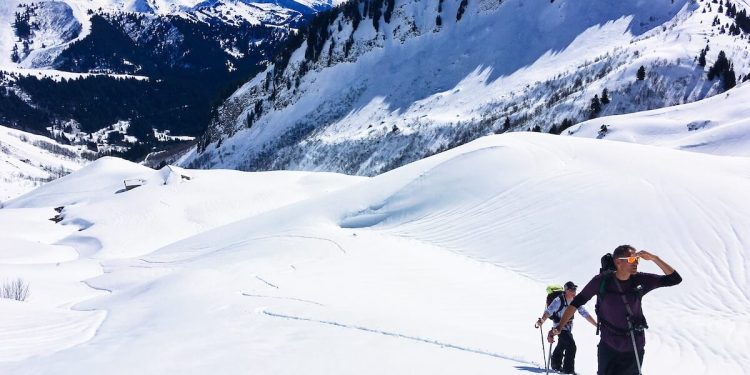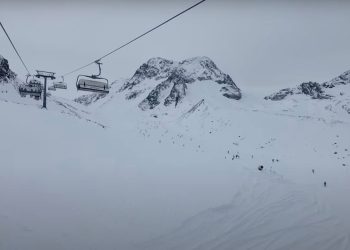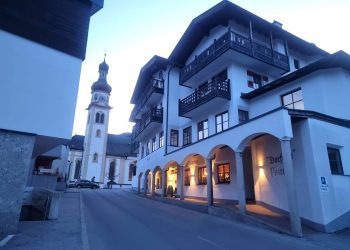During your recent visits to a ski resort, you may have seen quite a few people slogging their way uphill on skis. It may seem like a silly thing to do when there’s a perfectly good system of ski lifts to get you up the mountain.
However, there are several excellent reasons why people ascend the hard way, and you may be surprised to learn that some of these “uphill skiers” are actually snowboarders with special equipment. So, in this blog, I will talk about this equipment and give you 4 reasons to try splitboarding.
What Is A Splitboard?
Let’s start with the basics. A splitboard is a snowboard that splits down the middle to make a pair of skis. Splitboard bindings are specially designed to slide off the board and be refitted onto the skis pointing forward. In “ski mode”, the bindings have a “free heel,” meaning they are fixed at the toe where they hinge, allowing you to stride forward.
To hike up a snowy mountain on skis, you need another piece of specific equipment, “skins”. These are strips of textured material that stick to the base of your skis. They have bristles that grip the snow to stop you from sliding backwards as you make your way uphill.
You also need a pair of collapsable or telescopic poles for when you’re in ski mode that shrink down small enough to fit in your backpack for the ride down.
For some splitboard tours, you may need a set of splitboard crampons. These spikey metal contraptions clip into position under your feet to give you purchase on ice and steep slopes.
When you get to the top of the mountain, you simply re-build your snowboard, re-pack your bag and enjoy the ride back down.
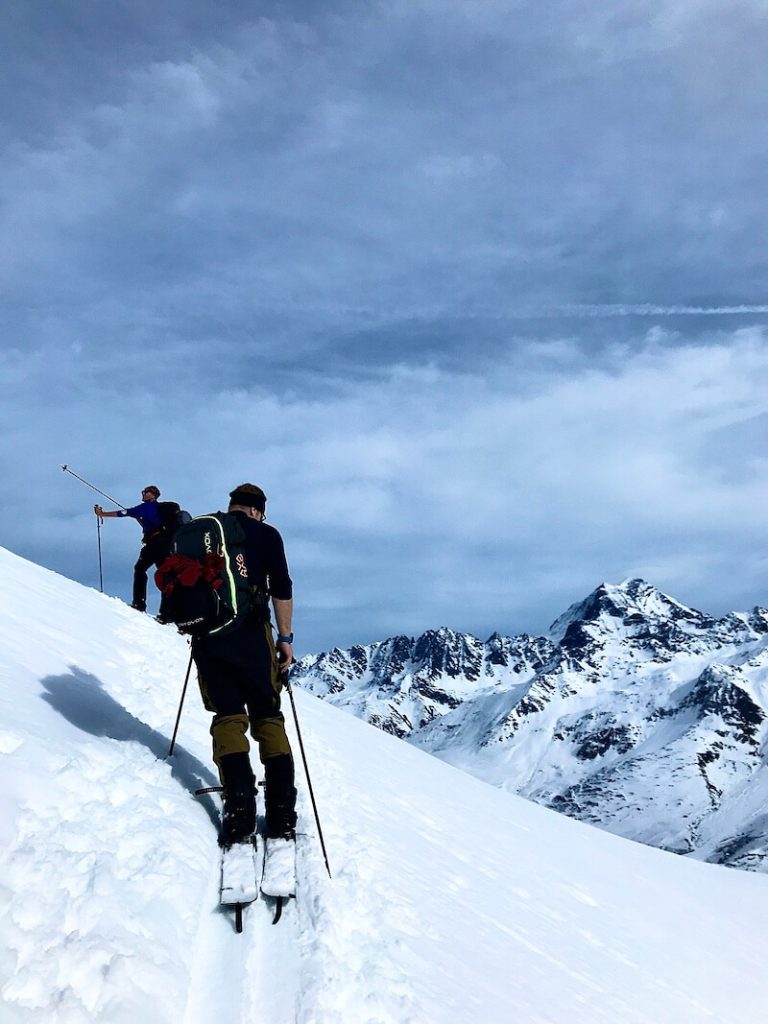
4 Reasons To Try Splitboarding
I live in the French Alps, where splitboarding is incredibly popular and becoming more so every season. Quite a lot of local snowboarders have a splitboard in their quivers, and here are a few reasons why:
1. Go Powder Hunting
Ski resorts are getting busier, so the lift-accessible powder gets tracked out incredibly quickly. But with a splitboard, you can hike into the backcountry and head to slopes that the punters don’t even know exist.
Depending on the conditions, a splitboard lets you ride untouched powder several days or even a couple of weeks after the last snowfall. However, I need to mention that you can’t just head off into the backcountry without a transceiver, probe, shovel, and knowledge of how to use them. You also need to be educated on avalanche awareness so you don’t get into trouble in the first place. I have been on several avalanche awareness courses, so I know what to look for and make an informed decision of whether to continue or turn back.
But, with a little bit of effort and knowledge, you can find your own slice of powder heaven.
2. Get Away From The Crowds
Peak weeks in ski resorts can be a nightmare. The concern of being taken out by an out-of-control skier or snowboarder is real. It’s also frustrating when you have to have your head on a swivel to try and avoid little Florance or Sebastian cutting across the piste in an aggressive snowplough.
Heading out on your splitboard means you can avoid all this and don’t have to contend with lift queue rage. It helps to know the area, but a guide or instructor can show you the best places to go. An instructor would love to take you on a splitboard tour, too; it’s much preferable to spending all day on the nursery slopes.
3. It’s Excellent For Fitness
It may be no surprise to you that hiking up a mountain can take a lot of effort. But there are a few things you may not realise at first.
Altitude makes your ascent much more difficult. It isn’t easy to pace yourself in the early days, but you soon learn that you can’t just march up the mountain, even if you’re fit. This is especially true if you’re not used to being above sea level, as your battery will soon run flat.
The next thing that makes splitboarding challenging is there are a few techniques to learn. The main one is the “kick turn.” You’ll see ski tourers and splitboarders take a zig-zag route up the mountain. This is to make steeper ascents easier. I still get kick turns wrong, which is incredibly frustrating, especially when you fall over and slide back down, undoing your last two kick turns! But, once you get the technique dialled in, a well-executed kick turn is very satisfying. It also means you can keep a good rhythm speeding up your ascent.
As I mentioned earlier, splitboarding requires a lot of equipment, some of which is heavy. For example, I splitboard with an airbag backpack designed to inflate if I get caught in an avalanche, hopefully keeping me closer to the surface. This is heavy by itself, but when you add extra layers, water, food, crampons and an ice axe, the weight jumps considerably, even more so if you have an overnight stay in a refuge. You don’t always need this stuff, as it depends on your route, so planning and smart packing are key.
All this builds muscle and burns calories. It also makes that first sip of beer even better at the end of the day.
But you don’t need to go on a massive mission. I often use my splitboard to take my dog for a walk. It is an excellent workout, and it really tires him out, but the most important thing is that we both enjoy it.
4. Splitboarding Gets You Out In Nature
Splitboarding isn’t just about the descent. If it was, you’d be pretty crazy to hike up for several hours for a descent that lasted a few seconds. You need to think of splitboarding as a different style of snowboarding. Yes, the descent can be amazing, but the hike up is surprisingly fantastic, too.
Being away from the crowds and screens is incredibly good for you. You spend the whole time looking for the best route and spotting lines you want to ride. “I’m going to slash that wind lip,” “I wonder if I could land that drop with this backpack on,” “That couloir looks amazing,” “That bit looks like it might avalanche, so I’ll take another line.”
If you’re lucky, you get to see wildlife. I often see eagles, vultures, chamois, and Ibex. I’ve yet to see a wolf, but I’ve seen their pawprints a few times.
Alpine views are one of my favourite parts of splitboarding. There’s nothing like seeing the snow-covered peaks from a distance and the odd occasion Mont-Blanc isn’t covered in clouds. It also allows you to spot potential new splitboard routes from afar, as there’s always another mountain to experience.
Ready To Try Splitboarding?
I have to say that splitboarding is one of the most rewarding forms of snowboarding. You certainly earn your turns, but it doesn’t have to be extreme and dangerous. You can have a lot of fun on mellow terrain while getting out in nature.
It may seem like hard work, and it can be, but it is worth it for the views and the potential epicness of your descent. If you fancy trying splitboarding, book an introductory lesson to learn how to use all the equipment, stay safe, and get to some excellent terrain and powder.
Check out more of Tom’s work at his website: https://thomasfortune.com/

